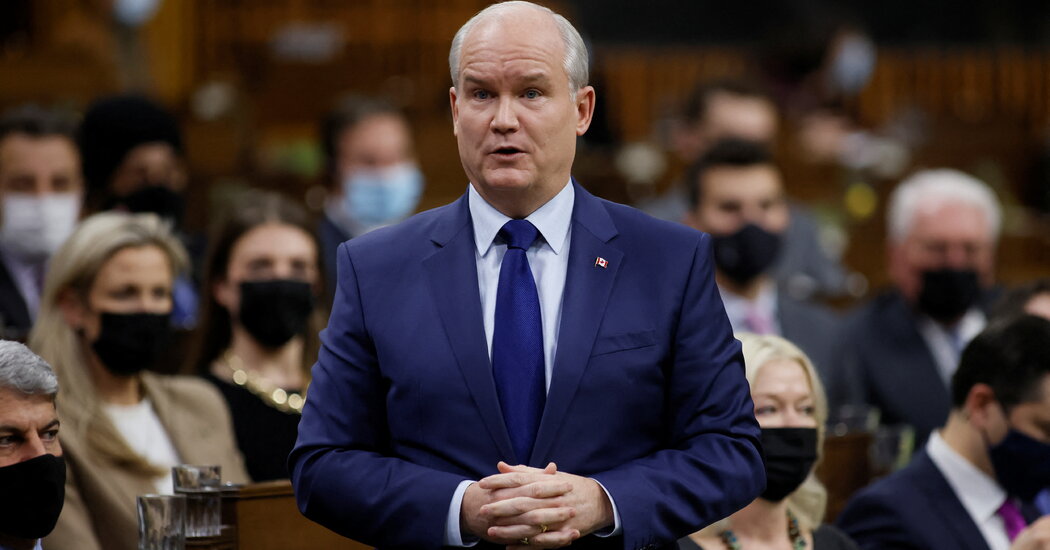
MONTREAL — Erin O’Toole, the leader of Canada’s opposition Conservative Party, was ousted in a vote against his leadership on Wednesday, providing a political lift to the minority government of Prime Minister Justin Trudeau, buffeted by pandemic fatigue and divided opinion over his stewardship of the country.
In a secret ballot, the Conservative caucus voted against Mr. O’Toole, 73-45, according to a statement from the caucus chair, Scott Reid. The vote was forced by a petition from caucus members concerned that Mr. O’Toole had taken the party too far away from its core conservative values on social issues.
On Wednesday evening, the caucus selected Candice Bergen, the deputy leader and a former cabinet minister, as the party’s interim leader. Party rules do not allow Ms. Bergen, who is from the Prairie Province of Manitoba, to seek the post permanently at an upcoming leadership convention.
The vote against Mr. O’Toole appears to have been triggered by Conservative members angered by his support of a Liberal government bill banning conversion therapy earlier this year.
The vote is something of a political gift for Mr. Trudeau, a polarizing figure who has been grappling with the invasion of the Omicron variant and intensifying frustration over pandemic restrictions. There are economic challenges, too, including inflation of nearly 5 percent, the highest in 30 years.
While a Jan. 27 poll by the Angus Reid Institute, a not for profit polling group, showed that about half of Canadians approved of Mr. Trudeau’s handling of the pandemic, his overall approval rating shrank to 42 percent from 50 percent a year ago.
The Conservative Party is now looking for a new leader for the third time in five years. The ouster of Mr. O’Toole, 49, also suggests a widening of the rift between its more socially conservative wing, which is largely based in Western Canada, and its fiscally conservative, socially liberal branch that is centered in Ontario, the most populous province and Mr. O’Toole’s home.
Mr. O’Toole, who was defiant before the vote, offered some advice to his successor in a prerecorded video after the vote.
“This country needs a Conservative Party that is both an intellectual force and a governing force,” he said. “Ideology without power is vanity. Seeking power without ideology is hubris.”
He added that he would remain the local member of Parliament for his constituency, in an area to the east of Toronto.
Even before the vote on Mr. O’Toole’s leadership, some frustrated Conservative Party members of Parliament were already calling for his departure after he failed to defeat Mr. Trudeau’s Liberals when he fought his first federal election as Conservative Party leader in September. It was the Conservative Party’s third consecutive loss against Mr. Trudeau.
Mr. O’Toole, who was picked as leader less than two years ago, came to the election campaign as something of an unknown quantity among Canadians. He was elected as Conservative leader by appealing to the party’s right wing with a platform that promised to “take back Canada.”
Once installed as leader, however, he quickly tacked left and alienated many among the party’s conservative branch with his attempt to broaden the party’s appeal. After he failed to win last fall’s vote, Mr. O’Toole was criticized by Conservatives on the right for being a political clone of Mr. Trudeau, masquerading as a conservative.
Among other things, he abandoned a promise not to introduce a carbon tax and drew ire from some Conservative caucus members by abandoning a pledge to repeal Mr. Trudeau’s ban of about 1,500 models of military-style rifles.
He also sought to cast himself as a compassionate conservative, distancing himself from the party’s social conservatism on issues like L.G.B.T.Q. rights and abortion while reaching out to union members, a group that has traditionally supported the left-of-center New Democratic Party.
Ultimately, however, Mr. O’Toole’s repeated reversals on policy issues raised questions about exactly what he stood for, said Duane Bratt, a professor of political science at Mount Royal University in Calgary, Alberta.
“It happened really suddenly,” Professor Bratt said of Mr. O’Toole’s ouster. “But all the roots were there. I would say the roots were there even before the election.”
While the Conservatives did score a symbolic victory in the last election, winning the greatest share of the popular vote, the concentration of Conservative support in places like Alberta meant that it didn’t translate into the largest number of seats. Mr. O’Toole also came under criticism after the Conservatives failed to do well in electorally important urban centers like the Toronto area and Metro Vancouver despite his shift to the center.
“There’s an obvious ‘you didn’t win the election, get out’ feeling in the Conservative movement that is probably not fair,” Professor Bratt said. “He probably needed two tries.”
The loud and sometimes violent protests by truckers and others against vaccination mandates and pandemic measures, which have paralyzed downtown Ottawa since the weekend, again revealed the tensions between Mr. O’Toole and his caucus. It was only after several caucus members, including Ms. Bergen, endorsed the movement that Mr. O’Toole, who favors vaccination, joined in. But unlike many caucus members, he nevertheless kept his distance from the protests themselves and only met with representatives from the group at an undisclosed location and without any journalists present.
By contrast, Mr. Trudeau, keeping with the overwhelming public mood, called the protesters a fringe group and condemned them for violence, racism and spreading misinformation.
The current Conservative Party was created in 2000 through a merger of the Canadian Alliance, which began as a Western protest movement, and the Progressive Conservative Party, which formed Canada’s first modern federal government in 1867.
Professor Bratt said that little remains in the party of the more moderate Progressive Conservatives.
“There were moments where he was trying to kick in and drag his party to the center,” he said of Mr. O’Toole. “And there were elements of that party that did not want to go that way. There is no progressive wing in that party anymore.”



